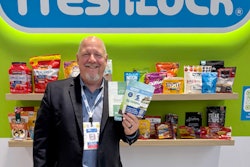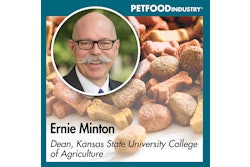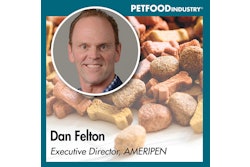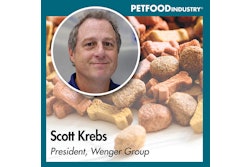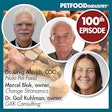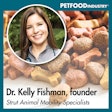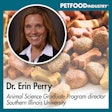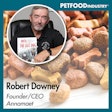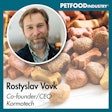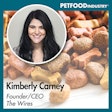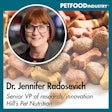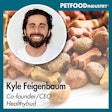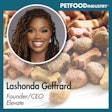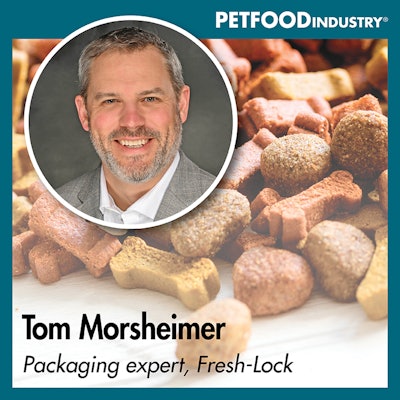
In this episode of the Trending: Pet Food podcast, Tom Morsheimer with Fresh-Lock and host Lindsay Beaton discuss the latest trends in packaging and learn exactly what consumers expectations are when it comes to pet food packaging.
The below transcript is from Episode 45 of the Trending: Pet Food podcast where host and editor Lindsay Beaton discusses with Tom Morsheimer, packaging expert with Fresh-Lock, the pet food packaging experience from the consumer perspective. You can find the episode at Trending: Petfood Podcast, on SoundCloud or on your favorite podcast platform.
We want to thank AFB International for sponsoring this podcast. AFB is the premier supplier of palatants to pet food companies worldwide, offering off-the-shelf and custom solutions and services that make pet food, treats and supplements taste great.
Lindsay Beaton – Editor, Petfood Industry magazine and Host, Trending: Pet Food podcast: Hello, and welcome to Trending: Pet Food, the industry podcast where we cover all the latest hot topics and trends in pet food. I’m your host and editor of Petfood Industry magazine, Lindsay Beaton, and I’m here today with Tom Morsheimer on behalf of Fresh-Lock. Hi, Tom, and welcome back.
Tom Morsheimer, packaging expert with Fresh-Lock: Hi, Lindsay. Thanks for having me back. It's great to be here.
Beaton: Tom has been a member of the packaging community for over 23 years and his extensive experience is rooted in his diverse technical background.
Tom began his career in packaging supporting manufacturing operations at Tenneco in the late 1990s. He joined the specialty products division of Pactiv Corporation in 2001 as an automation specialist working on leading edge product and process development for flexible packaging closure technology. Tom has collaborated on many notable market-first innovations over the span of his career in applications ranging from consumer food to pet care to household chemical. Fresh-Lock, from Presto Specialty Products, is a leader in flexible packaging closures. Presto is a business of Reynolds Consumer Products.
Tom is, it’s safe to say, an expert in the packaging space, which is why I've brought him on today to answer this question: What is the experience of pet food packaging like from the consumer perspective?
I don't think we can have a really solid conversation about packaging without talking a little bit about the big trends that are going on right now and how those trends are impacting the way that pet owners interact with and use pet food products. What are some of those trends that you're seeing right now?
Morsheimer: That’s a great question, Lindsay. I recently got a sneak peek at the 2023 Premium Pet Food Consumer white paper that Mondi group and Dow have been collaborating on starting way back in 2019. This pet consumer survey is conducted every three years, and it's now in its third wave of tracking. It's producing the results that there are two long term trends and mainstays that pet food packaging must deliver on to meet pet parent expectations.
The first is packaging needs to provide clear and easy-to-read nutritional information about the product. This is number one for many pet parents. They want assurance that the food they provide to their pet is made with the highest quality ingredients and that deliver important nutrients to promote the health, longevity and overall well-being of their pets.
The second priority that packaging needs to deliver on its freshness. Pet parents expect packaging to deliver a high level of protection and freshness throughout the lifecycle of the product, so that the last feeding occasion is as good as the first. This expectation is achieved by using high-quality films that carry grease resistance and barrier protection along with the inclusion of value-added features that are fit for use and reclosable to keep air and contaminants out and freshness in, thereby extending the shelf life of the product inside.
Beaton: I feel like either one of those angles would be quite enough to be focusing on, right? One of them is about the packaging itself and how it operates with the product. The other one is what's on the packaging and using packaging as a vehicle to communicate information. How many stakeholders and how many different players are involved in having to deal with both of those things at the same time when you're creating packaging?
Morsheimer: That's a great question. There's a lot of stakeholders that are involved in creating packaging. I think when it comes to the design of packaging, I mean, obviously the brands are involved. Then they're leveraging their suppliers, such as the converting companies, the closure suppliers.
It’s really a collective process that everyone in the supply chain plays a key role in delivering on all these value propositions and performance the packaging needs to provide.
Beaton: When clients come to you, are they normally looking for both of those things in tandem? Or do companies tend to have one concern over the other?
Morsheimer: They will typically come to us with both. I can tell you that from my experience, usually value-added features or recloseability is typically a little bit left to the side in terms of the overall scope of the project. More often than not, I think zippers and sliders and other reclosable features are too often treated as an afterthought or non-essential to packaging decisions, when in reality, the value-added features are something that consumers are increasingly evaluating in their purchasing decision process.
Beaton: As consumers are starting to pay more and more attention to packaging in all its facets, what are some of the biggest challenges that pet food manufacturers are facing when it comes to designing packaging that's both functional and visually appealing?
Morsheimer: There's a lot of challenges that are faced by pet food manufacturers when it comes to designing packaging. It's hard to say which ones are the biggest. My best advice to brands, when in the packaging design phase, is to first clearly identify all the goals that the package needs to deliver on. This includes product protection, clear nutritional information, high-impact graphics, brand recognition, along with recyclability and other sustainable aspects, including cost.
My second piece of advice is for brands to leverage their suppliers to help guide them through this process. Ideally, this should be done as a collaborative effort between film suppliers, closure suppliers, converters and OEMs. It's really the collective knowledge base that everyone can bring to the table as the best recipe for success.
Beaton: How much education are you doing with your clients these days? Do people generally come to you knowing exactly what they want? Or is it more of a “here's our product, here's how we need to get it to consumers, can you help us build the correct packaging to put this product in?”
Morsheimer: I wish it was as simple as that, but it's not. We're constantly educating our customers, whether it's brand customers or whether it's packaging converters, just about the different features and the different challenges that comes to adding recloseability and other value-added features to packaging.
There are all sorts of sizes and different formats and shapes that pet food packaging can come in. It's important for brands to consider the value that reclose features deliver when designing packaging. There's a constant level of education that's going on all the time in terms of the types of zippers, the machinery that it needs to run on, what they want it to deliver to consumers. There are several factors that come into play and that need to be evaluated here.
Beaton: I feel recloseability is a huge convenience factor. Is it something that you're seeing more requests for these days? I feel like convenience is one of the big trends people are looking for in their packaging right now.
Morsheimer: Absolutely. Convenience is something that consumers are looking for, and pet parents are looking for in particular. Packaging represents the main interaction point with the product itself. The feeding of pets can be a responsibility for the entire family, so it's important that packaging features meet a wide range of requirements, such as handles to ease transport of the product along with gusseted or flat bottoms that enable stability and make storage more convenient.
When it comes to the recloseability features, they need to be easy to operate, functional and fun to use. What I mean by that comment is that packaging and features should delight consumers and be interactive.
Beaton: Yeah, I want to talk a little bit more about that. Because I know that when I have, say, a treat package, because I have two cats and a dog, and there is a recloseability feature to it, the noise that the opening of that product makes is the thing that brings my animals running. Is something like that a way that consumers could use packaging to interact more with their pets and make things more fun and more interactive between themselves and their animals?
Morsheimer: Absolutely, Lindsay. I'm glad you brought that up, because that's something that we're seeing as a trend in flexible packaging, and especially in the pet space.
We're developing new products such as sensory zippers that provide an audible and tactile feedback to pet parents and consumers. The value there is twofold. It provides confidence that when they’re closing, that they've secured the product and locked-in freshness, but also it delivers a repeatable opening experience that gives users the sensation of opening the package for the first time where you get that ripping sound and that's the audible cue for pets. It really does create an interactive relationship between pet owners and their pets.
Beaton: That's really interesting. How do you go about creating something that reclosable and purposely audible? Do they look or operate differently from more traditional zipper-type items? Or is it a matter of making the teeth a little louder? How does that work on the technical side?
Morsheimer: On the technical side, the way we achieve that is basically we use a multitrack closure. Traditionally zippers, you have two interconnecting features, that we identified usually as a male and female side, to employ something like audible or tactile. What I mean by that -- the audible part of it is the zipper clicks when you close it. When you run your fingers across it, you get a clicking feedback from the zipper. When you open it, you get a sense a ripping or an opening sound. We see this a lot with closures, like Velcro-type closures.
What we do is we use multitrack and deform one lane of the track, which delivers the audible and tactile sensory feedback. The addition of multitracks also provides a much more robust reclose path for consumers, as opposed to the traditional single-lock zippers.
Beaton: We're talking a little bit about new technologies and things that are going on in the pet space right now. What kinds of opportunities are out there that connect the current trends that consumers are asking for, like sustainability is obviously a big one in packaging, because packaging is such an obvious “target” for things like recyclability. It's just a very physical component of the sustainability conversation. What is going on out there right now that makes you excited for what's happening in the packaging space and how it's evolving?
Morsheimer: When it comes to the topic of sustainability, that's obviously playing an enormous role in the packaging decisions for most, if not all, brands in pet food, as well as any other package consumer goods. What this sustainability conversation has really done is created different growth paths, or different alternate methods, of packaging products that are going into the marketplace to help manage the end of life.
Traditionally, plastic has been a primary material that has been used. Some of the challenges that have come with traditional flexible packaging that are produced in plastic is that it's multi-material. What's been going on in the industry is really a streamlining to move multi-material plastic formats into mono-material structures that enable a better outcome for those materials in the form of mechanical or chemical recycling versus landfill.
We're also seeing a huge resurgence in the use of paper packaging. This is becoming more and more popular with many brands. A lot of it has to do with the high collection and recycling rate of paper-based products, because there's a very robust, established infrastructure for that.
There are also newer materials that are emerging all the time. We're seeing a big demand increase for compostable packaging formats -- those are materials that are made with a mixture of biobased and fossil-based biodegradable materials that deter that packaging from leaving the circle as waste and typically go into some sort of industrial compostable facility as soil amendments.
Beaton: Are there any pain points right now for packaging suppliers? Is technology pretty much there to answer all these questions, and it's more about education and refinement? Or are there things that the packaging space is still developing, and you'll get there, but you're not quite there yet from a production standpoint, from being able to create the packaging that people are starting to ask for?
Morsheimer: There's always ongoing challenges. The job is never done really, and we need to be continuing to push development and the reduction of the amount of packaging materials that we use. Gone are the days of overpackaging. Simply based on the availability of materials or the convenience, we need to move away from heavier materials. Those are efforts that are being done and pushed by brands and by consumers that we're never going to see go away.
There are a lot of challenges. I think that one of the most important things that we need to put special effort on is probably the education and the investment into the collection and recycling of packaging materials. This is an area where I think consumers are a little bit “deer in headlights.” Sometimes it's difficult for them to know exactly what their packaging material is made of or what they're supposed to do with it in terms of end of life. That's an area where we need to put a lot of focus in the education of consumers in how we educate them on what to do with these materials to properly dispose or to recycle them.
Beaton: How do you guys do that? Do you have a lot of direct channels to the end consumer? Or is it more education of the pet food manufacturers who then pass on that knowledge? Or are there associations you work with or government regulations? Where are your channels for education right now in terms of that sort of thing?
Morsheimer: There are a lot of channels. There are organizations such as the Flexible Packaging Association. They're more focused on interacting with government in the legislation and the rules around packaging. A lot of the consumer education falls back onto the brands and what they're communicating on the packaging. Fresh-Lock’s role in that process is to make sure that we're aligning the products and the materials that we're using in the development to support the overall packaging format. If a customer wants to develop a paper packaging format, for instance, it's up to Fresh-Lok to develop, for example, a reclose feature that provides that product freshness value aspect to the consumer. What do we need to be doing behind the scenes to develop those materials and those processes that complement the overarching paths that a lot of these brands are taking?
Beaton: Did you guys have those systems in place before this current stretch of packaging evolution? Or is the idea of hardcore education something that's a little newer to packaging suppliers?
Morsheimer: I don't necessarily think it's newer, but I think there's a much higher emphasis on packaging education. In my 24 years, packaging, flexible packaging especially, has evolved enormously. Packaging is something that will constantly be changing. The types of packaging, how packaging is produced, what it looks like, what it feels like, what does packaging communicate to consumers -- that's something that's going to be ongoing until the end of time.
Recently, we've seen a bigger shift, in terms of -- traditionally, consumer purchasing was always done at brick-and-mortar stores. Now there's omnichannel. Consumers are purchasing their products either in person at a store or they're going through online channels. The packaging requirements for those two different retail paths can be different. Protecting product, shipping to a store shelf can be a little bit different in some cases, then product protection and delivery through e-channel.
Beaton: How does that work on your end? If a pet food manufacturer comes to you, and says, “We need this packaging to work, both in a retail space and we need to be able to ship direct to consumer or it's going to go sit in a warehouse for a while and ship from there?” Do you treat those as two completely separate projects? Or is it one project with a dual focus?
Morsheimer: It varies, but typically, it's one project with a dual focus. We have a wide range of different closure technologies, so we never take the approach that one size fits all. Every product, every application is unique in its own right. We treat those opportunities individually to make sure that we're meeting whatever the expectations may be for each individual application.
Beaton: We've talked a little bit about the past of packaging. We've been spending a lot of time in the present of packaging. And now I want to hear a little bit more about how you think pet food packaging is going to continue to evolve over the next few years. What kinds of new features or technologies might we see emerge?
Morsheimer: I mentioned early on in our conversation that closures should be fun. What I meant by that was we want packaging features to delight consumers. We want to provide that interactive interface with the packaging. We're already seeing some of this evolution where packaging is advancing from just providing curb appeal to a source of information and user experience.
A good example would be the addition of things like QR codes that can be printed on packaging and provide a link to highly detailed information about product ingredients and their source and specific batch information. Value-added features are also evolving. We discussed the sensory zippers to provide the audible and tactile feedback to consumers.
The other thing that we see is there's a continual evolution alongside consumer packaging that packaging needs to deliver performance and functionality using the least amount of material necessary to get the job done -- that packaging is managed in a responsible way.
Beaton: That sounds like a lot. Is it a lot? Or is it just par for the course for packaging right now?
Morsheimer: No, I would say it's a lot, Lindsay. Packaging in recent years -- I would say in the last five years -- packaging is going through a renaissance period. Traditionally, plastic was just the go-to packaging format for just about everything you bought at store shelf, including cat food packaging. The pet food market is much more diverse than other consumer food applications. In terms of the types of formats and the different sizes, you've got everything from woven polypropylene to some multiple papers still out in the market and plastic packaging.
Now we're seeing brands that want to focus in on sustainability and moving to compostable formats. There's a lot always going on in terms of development and innovation and competitiveness in the market. A lot of that is driven by brand competitiveness. Brands are looking for ways to differentiate themselves from their competition at store shelf and other retail channels. It's really driving a lot of engineering and research and development down into the supply chain and that trickles all the way down to us a Fresh-Lock for sure.
Beaton: Well, all of that going on is why I really appreciate you coming on to talk packaging with me. There are so many angles to discuss it from, but the consumer experience is a significant driver in development and trends, which is why it's important to at least try to get a handle on everything that's going on. Before we go, let's do a little plug. Where can people find more information about you and more about Fresh-Lock?
Morsheimer: They can find information about me on LinkedIn, and the best place to find information about Fresh-Lock and our product portfolio is by visiting our website at fresh-lock.com.
Beaton: And that is it for this episode of Trending: Pet Food. You can find us on PetfoodIndustry.com, SoundCloud or your favorite podcast platform. You can also follow us on Instagram @trendingpetfoodpodcast. And if you want to chat or have any feedback, I'd love to hear from you. Feel free to drop me an email: [email protected]. And of course, thanks again to our sponsor AFB International, the premier supplier of palatants to pet food companies worldwide offering off-the-shelf and custom solutions that make pet food, treats and supplements taste great. Once again, I'm Lindsay Beaton, your host and editor of Petfood Industry magazine, and we'll talk to you next time. Thanks for tuning in!



